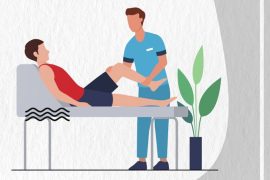Frozen shoulder, or adhesive capsulitis, is a debilitating condition characterized by pain, stiffness, and a significant reduction in the range of motion in the shoulder joint. This condition poses a considerable challenge to individuals, impacting their quality of life and hindering even simple daily activities. The precise cause of frozen shoulder remains elusive, confounding health experts. Shoulder pain, unexpectedly experienced by people of all ages, contributes to the complexity of this condition, making routine tasks a formidable challenge.
The symptoms of frozen shoulder necessitate a keen understanding for effective management and swift recovery. Individuals grappling with this condition often endure persistent pain and a notable limitation in the shoulder’s movement. Routine activities become arduous, emphasizing the need for comprehensive knowledge about the symptoms and available treatments.
Astonishing Flexibility and Precision of the Shoulder:
The shoulder, also known as the glenohumeral joint, is characterized by remarkable flexibility that facilitates a wide range of arm movements in different directions. Comprising a ball-and-socket structure, this joint involves the articulation of the upper arm bone (humerus) with the glenoid of the scapula. The joint is encapsulated by a flexible capsule filled with synovial fluid, ensuring smooth and pain-free movement. This intricate design allows for the versatility required in daily activities and highlights the importance of maintaining the health and functionality of the shoulder for overall mobility and well-being.
Symptoms of Frozen Shoulder:
- Limited Range of Motion: One of the most distinguishing features is a significant reduction in the range of motion of the shoulder joint. This limitation makes daily activities increasingly difficult.
- Gradual Onset: The condition typically takes two to nine months to fully develop. While the pain may gradually improve, the stiffness persists.
- Stiffness: Frozen shoulder starts with stiffness that worsens over time. The affected shoulder becomes progressively less mobile.
- Pain: Individuals with frozen shoulder experience persistent, dull, and aching pain, particularly when attempting to move the arm.
Decoding Shoulder Discomfort:
- Persistent Pain: Shoulder pain can range from mild and achy to severe and stabbing. The intensity of the pain can vary, and it may be exacerbated by shoulder movement. The pain can be localized to specific regions of the shoulder.
- Stiffness: Restricted range of motion is a common sign of shoulder pain, making it challenging to perform everyday tasks such as reaching behind the back or overhead.
- Long-Term Weakness: Shoulder pain can lead to a loss of strength in the affected area, making activities that involve lifting or carrying things more difficult over time.
- Increased Instability: Some individuals with shoulder pain report a feeling of increased joint instability, as if the shoulder joints are loose or might “pop out.”
- Inflamed Area: Inflammation in the shoulder joint can cause soreness, swelling, and increased sensitivity in the affected area.
- Popping Sounds: Audible clicking or popping sounds when moving the shoulder may indicate an issue with the joint.
Shoulder pain can result from various causes, including injuries, inflammation, or underlying medical conditions. Seeking medical advice is crucial for an accurate diagnosis and appropriate treatment based on the specific cause of the shoulder pain.
Causes and Risk Factors:
- Underlying Conditions: Certain medical conditions, including thyroid disorders, diabetes, and Parkinson’s disease, are mentioned as potential contributors to an increased risk of developing frozen shoulder. These underlying conditions may impact the shoulder joint over time.
- Immobilization: Frozen shoulder can occur when the shoulder has been immobilized for an extended period. This immobilization may result from injury, surgery, or illness.
- Overuse Injuries: Conditions like tendinitis or bursitis of the rotator cuff can lead to inflammation, which may contribute to the development of frozen shoulder. Overuse injuries can strain the shoulder joint and surrounding tissues.
Treatment:
- Rest and Activity Alteration: Allowing the shoulder to rest and avoiding activities that exacerbate pain is an initial step in managing shoulder pain. Sufficient rest is essential for proper healing.
- Physical Therapy: A customized program of stretches and strengthening exercises, developed by a physical therapist, can improve shoulder mobility, stability, and overall function. Physical therapy is often a crucial component of rehabilitation.
- Medications: Over-the-counter non-steroidal anti-inflammatory drugs (NSAIDs), such as ibuprofen, can be used to control pain and inflammation associated with shoulder issues.
- Hot or Cold Packs: Applying heat or cold packs to the affected shoulder can help relieve muscle tension and reduce inflammation, providing additional comfort.
- Shoulder Joint Steroid Injections: Administered under aseptic precautions by a pain specialist, these injections can be beneficial when conservative methods fail to alleviate shoulder joint issues. Steroid injections can help relieve discomfort without the repeated use of painkillers.
- Surgical Intervention: In extreme cases or when conservative therapies are ineffective, surgery may be necessary to address shoulder pain. The goal of surgery is to stabilize the shoulder joint or repair damaged tissues.
- Anti-Inflammatory Medications: Medications such as aspirin, ibuprofen, or naproxen are prescribed to reduce pain and swelling in the shoulder joint. These are commonly used to manage the symptoms associated with inflammatory conditions.
- Corticosteroid Injections: Injections of corticosteroids can be administered to alleviate inflammation in the shoulder joint or soft tissues. These injections can provide targeted relief for individuals with shoulder pain.
- Physical Therapy: Physical therapy is a fundamental aspect of treatment, involving stretching exercises to regain flexibility and later incorporating strengthening exercises. A physical therapist guides individuals through these exercises, ensuring a safe progression in the rehabilitation process.
- At-Home Exercises: In addition to professional physical therapy, individuals are encouraged to perform gentle at-home exercises to maintain and improve their shoulder’s range of motion. Consistent exercises can contribute to overall recovery.
- Surgery: When non-surgical approaches are ineffective in improving the patient’s quality of life, surgical interventions may be considered. Surgical options can include shoulder manipulation under anesthesia or arthroscopic capsular release. These procedures aim to address the underlying issues causing the shoulder stiffness and limited range of motion.
Lifestyle adjustments to manage and reduce the risk of shoulder pain:
- Proper Posture: Maintaining proper posture is highlighted as a helpful measure in easing shoulder pain. Good posture can contribute to the overall well-being of the shoulders and prevent strain.
- Avoiding Repetitive Overhead Movements: Repetitive overhead movements are cautioned against, as they may lead to shoulder impingement. This type of movement can put stress on the shoulder joint and surrounding structures.
- Frequent Workouts for Shoulder Strength and Flexibility: Regular workouts that focus on the shoulders are recommended to keep them strong and flexible. Incorporating exercises that target shoulder muscles can contribute to overall joint health.
- Lifting Objects Properly: Proper lifting techniques are emphasized to prevent excessive strain on the shoulders. This includes using proper body mechanics and lifting objects in a way that minimizes stress on the shoulder joints.
Recovery from a frozen shoulder:
Recovering from a frozen shoulder is a gradual journey that spans several months to a few years. The key to successful recovery lies in steadfast adherence to prescribed exercises and treatment plans, enabling most individuals to achieve significant improvement without resorting to surgical intervention. However, should challenges arise or if one reaches a plateau in their recovery, seeking guidance from an orthopaedic sports medicine specialist is advisable. These experts can provide specialized insights and interventions to navigate any hurdles, ensuring a more effective and tailored approach to the rehabilitation process.
Disclaimer:
The information contained in this article is for educational and informational purposes only and is not intended as a health advice. We would ask you to consult a qualified professional or medical expert to gain additional knowledge before you choose to consume any product or perform any exercise.






